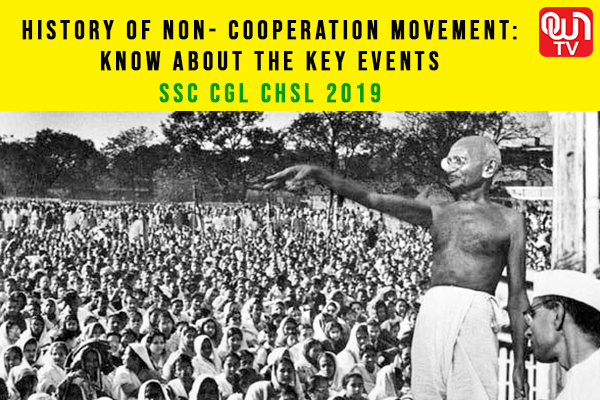All you need to know about the Non-Cooperation Movement- History Notes
The Non-Cooperation Movement: Know its history& key events
The Non-Cooperation movement of India started in 1920. It was undertaken by Indian National Congress under the leadership of Mahatma Gandhi. The Non-Cooperation Movement was a result of a series of events like the introduction of the Rowlatt Act, the Jallianwala Bagh Massacre, Martial law in Punjab, the neglecting of the Khilafat Committee aspirations, high prices of commodities, droughts and rising epidemics.
Read more: History of Jallianwala Bagh Massacre?

Let us first discuss each reason behind the Non-Cooperation Movement before moving on to the actual movement.
What was the Rowlatt Act?
The Rowlatt Act was the first event in the series of events that lead to Gandhi’s conversion to a non-co-operate. In 1919, The British Government passed a new Act to give themselves greater power called the Rowlatt Act on the recommendations of the Rowlatt Commission. The people of India strongly opposed this law because it makes the British government superior and authoritative. It allowed the British to arrest and Jail anyone without trial. The grounds were that if anyone is thought to be plotting against the British, they can be jailed without any trial. It also gave the Viceroy, power to silence the press.
Read more: Who was Razia Sultan? Facts you need to know!

The act sparked anger and discontent in the leaders and the common people. Gandhi even went on a hartal(fasting) to show his discontent but it was called off because it became violent. This went against Gandhi’s idea of non -violence and hence, Gandhi called off his hartal.
Jallianwala Bagh Massacre – Know its key events
It was 13th April 1919 when the people of Amritsar, Punjab were celebrating the festival of Baisakhi. Also, they were there to present their distress on the arrest and deportation of the National leaders, Satya Pal, and Dr Saifuddin Kitchlew

General Dyer ordered to close the centre and the only opening of the Jallianwala park and ordered fifty riflemen to kneel and fire. Reports say that there were 379 fatalities and 1,100 wounded.
Khilafat Movement: What was it?
At the all india khilafat conference,Muhammad Ali declared that it was religiously unlawful for the Muslims to continue in the British Army. The abolition of Khilafat was proposed when at World War I, Turkey got defeated by Britain. Turkey was fighting as an ally of Germany. The abolition of Khilafat was highly disappointing for the Indian Muslims. They then organised a protest under the Khilafat Leaders. Khilafatis gave a deputation to Viceroy but his reply disappointed them even more. The other deputation was with Lloyd George in London where they again faced the same disappointment. On 17th October 1919, Khilafat day is observed.
The Central Khilafat Committee on 1 August 1920 organized a strike. Several Pira and mullahs supported them. A special session of Congress took place in Kolkata in September 1920. In this resolution, the Non-Cooperation was passed.
These three were the main incidents that lead to the entire cooperation movement.
Beginning of The Non – Cooperation Movement
The non-cooperation movement was officially launched on 1st August 1920 by the INC under the influence of Mahatma Gandhi.This movement was a peaceful and violent protest of the British government. The idea was to simply not to cooperate with the British government.
To mark the set of the protest, India was asked to relinquish their titles also resign for the nominations in local bodies. People were to quit the government jobs, withdraw children from government-controlled schools or the government-aided schools and colleges.
People boycott foreign goods and we’re agitated to use only the Indian made goods. They were even asked to boycott the elections to the legislative council. They were asked to not to serve the British Army and even planned that if the following plan does work, they will even refuse to pay the taxes. The biggest thing which INC demanded was Swaraj I.e. Self government.
Calling off the Non-Cooperation
The Non-Cooperation movement was called off by Mahatma Gandhi in February 1922 with the Chauri Chaura Incident. On 10th March, Gandhi got arrested and from 18th March, he got imprisoned for six months under sedition. This finally called off the movement. Prior to that, in 1921, the Ali Brothers got arrested creating unrest in the country.
Although not many of the leaders of Congress stand behind Gandhi, several determined leaders left the path. Gandhi said that he called off the strike because not many leaders were ready to bring a change, fight against the British government with the path of Ahimsa. Though many leaders like Motilal Nehru and CR Das remained against the suspension of the movement because of the sporadic instance.
The Civil Disobedience movement is one of the most significant movements of the modern history of India before independence. This movement was an exemplary revolt against the British’s idea of ruling India. It was in result of the Rowlatt Act, the Jallianwala Massacre and the Khilafat Movement. These incidences show the brutality of the British Government and hence, the Non-Cooperation movement was launched by Gandhi to show complete non-cooperation. This topic specifically is very important for the competitive exams like SSC, UPSC, Bank Exams etc. Hence we hope you have learned the key features of Non-Cooperation movement.
For More Information Click Here
